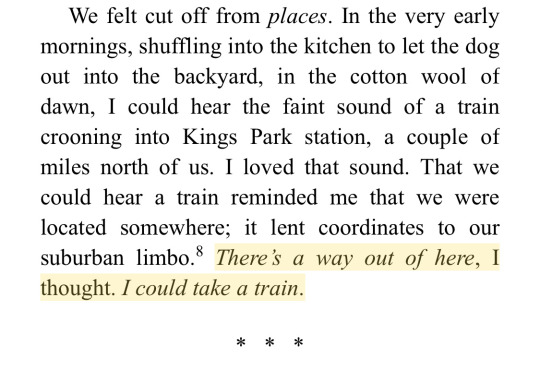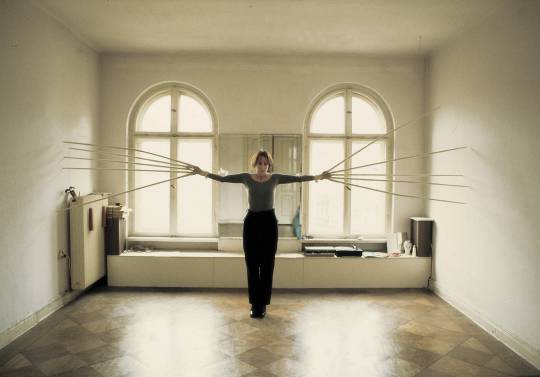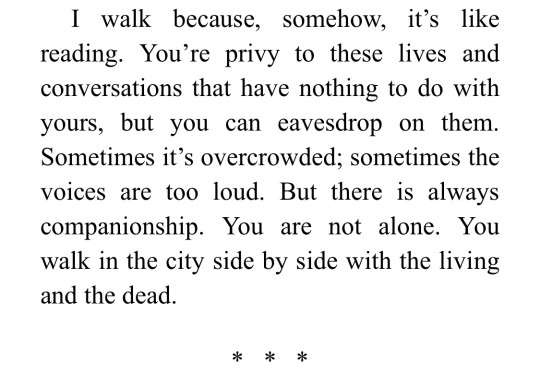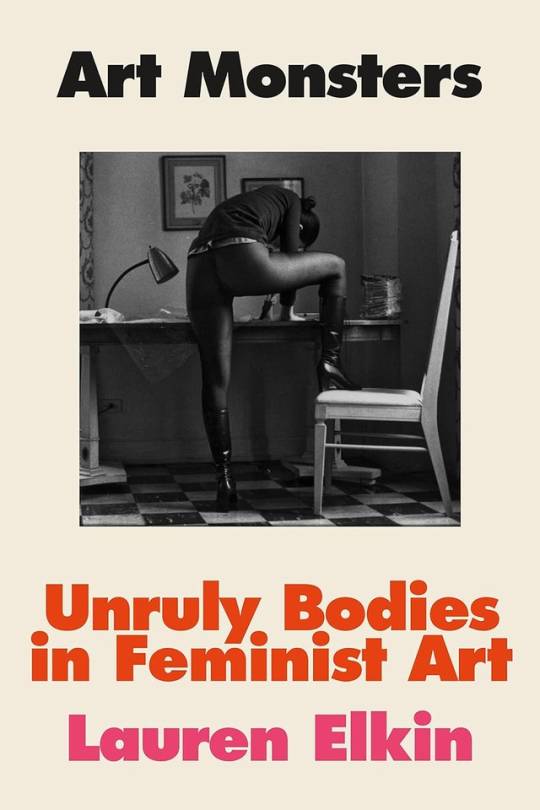#lauren elkin
Text


The streets of Paris had a way of making me stop in my tracks, my heart suspended. They seemed saturated with presence, even if there was no one there but me. These were places where something could happen, or had happened, or both." ~ Lauren Elkin, Flâneuse
#jamie campbell bower#vogue magazine#ysl#paris fashion week#jamie bower#such a mood#photography#photoshoot#quote#lauren elkin
36 notes
·
View notes
Quote
Like the bits of rubbish [Annie] Ernaux notices along the sides of the road—“A cookie wrapper a broken Coca-Cola bottle beer cans some newspapers […]”—these are bits of memory that perhaps don’t mean very much to anyone but in their very specificity and meaninglessness they are traces of being, of having been, in the world. Why note down all these people, these places these things? And yet what we note in our journals may speak as much about us as it does about the world. This is what Ernaux comes to understand in a belated preface to Journal de dehors: “I am sure, now, that we learn even more about ourselves when go out into world than in the introspection of the private diary.” That what we think of as the self is not contained within our minds and bodies but distributed across all the places we’ve been and all the people with whom we’ve crossed paths. And moreover, as Ernaux concludes in the last line of that book, “Doubtless I am, in the crowded streets and shops, a surrogate for other people’s lives.”
Lauren Elkin, from “Encountering Annie Ernaux’s Urban Landscapes and Scattered Selves”, published in Lit Hub, September 16, 2021
38 notes
·
View notes
Text

Lauren Elkin, Flâneuse
19 notes
·
View notes
Text

Lauren Elkin, from Flâneuse: Women Walk the City in Paris, New York, Tokyo, Venice, and London
2 notes
·
View notes
Quote
Walking is mapping with your feet. It helps you piece a city together, connecting up neighborhoods that might otherwise have remained discrete entities, different planets bound to each other, sustained yet remote. I like seeing how in fact they blend into one another, I like noticing the boundaries between them. Walking helps me feel at home. There's a small pleasure in seeing how well I’ve come to know the city through my wanderings on foot, crossing through different neighborhoods of the city, some I used to know quite well, others I may not have seen in a while, like getting reacquainted with someone I once met at a party.
Lauren Elkin
#Lauren Elkin#walking#mapping#feet#city#neighborhoods#map#entities#planets#remote#boundaries#home#pleasure#wandering#wanderings#foot#crossing#neighborhood#cities
3 notes
·
View notes
Text
0 notes
Text
0 notes
Text
I walk because, somehow, it’s like reading. You’re privy to these lives and conversations that have nothing to do with yours, but you can eavesdrop on them. Sometimes it’s overcrowded; sometimes the voices are too loud. But there is always companionship. You are not alone. You walk in the city side by side with the living and the dead.
Flâneuse by Lauren Elkin
1 note
·
View note
Quote
Ernaux charts the tangible moments of everyday life gleaned from the most undramatic of outings, on the RER, to the supermarket, to the mall. Ernaux’s work has often been called ethnographic, impersonal, even affectless in its restraint; but it is in the journaux extimes that we have the best evidence of how this apparent ethnographic project is actually an intensely focused project of memory, accessed from the present as it is remade moment to moment. There is nothing more personal, and nothing more—to borrow one of Ernaux’s terms—transpersonal.
Lauren Elkin, from “Encountering Annie Ernaux’s Urban Landscapes and Scattered Selves”, published in Lit Hub, September 16, 2021
20 notes
·
View notes
Photo

Rebecca Horn: Berlin Exercises Film. Touching the walls with both hands simultaneously, 1974. Photography Helmut Wietz.
via Lauren Elkin on ‘Art Monsters’ at Vogue:
“I came across the concept of the art monster in Jenny Offill’s brilliant 2014 novel Dept. of Speculation. I thought there was more to it—that perhaps we should direct our attention to the kind of work feminist artists had made. Somewhere towards the middle of writing the book, I realized I was less interested in legislating who was or wasn’t an art monster, but in using the term as a verb—art monsters. It disrupts, reroutes, surprises, undoes, and in that sense it has vital power.”
4 notes
·
View notes
Text

Lauren Elkin, Flâneuse
7 notes
·
View notes
Text
“Paris is not a ghost town, in spite of what they're saying on the American news. Since the morning after, people (at least in my neighborhood of Belleville) have been out and about, doing the kinds of things Perec noticed in 1974: buying food, drinking in cafes, carrying shopping bags, even (as we did) carrying a digital piano with its pedals and stand half a mile for a friend. We're defiant, but shaky. We can't get over what we've seen, what we've heard, who we've lost, and we don't really want to. But we'll eventually get used to the fact that it happened. It will become part of our daily lives.”
Excerpt From
No. 91/92
Lauren Elkin
0 notes
Text
where the heart is
a domestic syllabus [x]

"lecture on the history of the house" by claire schwartz
poem by american poet claire schwartz, published in poetry magazine and her 2022 collection civil service.
"the house. from cellar to garret. the significance of the hut" by gaston bachelard
the opening chapter to bachelard's seminal work the poetics of space. bachelard theorizes that the house's role as a site of reverie lends it a profound influence on the psyche. coining his own term, topoanalysis, to explore this influence; he surveys different poetic images of houses as representations of mind and soul.
the bedroom: an intimate history by michelle perrot, trans. by lauren elkin
french historian michelle perrot's history of the western bedroom as the site of birth, sex, illness, and death; from the ancient greek kamára to the postmodern bedrooms of today. perrot traces developments in the bedrooms of royalty, families, laborers, women, children, recluses, monks, and travelers. see also "black in bed" by art historian ella ray on the legacy of black bed art and "the bedroom of things" by caitlin blanchfield and farzin lotfi-jam for a discussion of private space through digital images.
rooms by rohan mcdonald
animated short film by illustrator rohan mcdonald featuring interviews with participants about their rooms and homes.
never home alone: from microbes to millipedes, camel crickets, and honeybees, the natural history of where we live by rob dunn
book by biologist rob dunn about the nearly 200,000 other species that live in our homes, from welcome pets to reviled pests. dunn's work researching the ecosystems of houses has illuminated the sheer scope of creatures that thrive there, often unbeknownst to both inhabitants and scientists, as well as the benefits of a biodiverse household.
"human stains" by heather havrilesky
author and "ask polly" columnist heather havrilesky on the endlessness of housework and "the strange gift that laundry brings to our lives."
the midcentury kitchen: america's favorite room from workspace to dreamscape, 1940s-1970s by sarah archer
a visual history of american kitchens, using examples of advertising and deisgn photography to show the evolution of their aesthetics, technology, and cultural ideals. see also sarah archer's episode of you're wrong about on martha stewart.
"full spectrum" and "if these walls could talk, listen, and record" by emily anthes
excerpts from the great indoors by science journalist emily anthes, which investigates the intersections of health and design in indoor spaces. "full spectrum" (republished by next city as "everyone has a basic right to good design") follows an apartment complex designed for autistic adults. "if these walls could talk, listen, and record" (republished by slate as "senior care homes are becoming high-tech medical devices") reports on the promise and limitations of smart home technology for the elderly.
"inside out, or interior space" by rebecca solnit
essay from rebecca solnit's collection of work on place, the encyclopedia of trouble and spaciousness. solnit discusses the pursuit of the "dream home" through decoration and renovation, examining our desire to craft the perfect nest.
windowswap by sonali ranjit and vaishnav balasubramaniam
a collaborative online database of user-submitted videos shot from windows around the world. conceived as a way to "travel" during early phases of the covid-19 pandemic, visitors can shuffle through videos to experience the views from homes in a plethora of different environments.
#syllabi#this is another one that could have gone on and on!#cover image is unmade bed by eugene delacroix
682 notes
·
View notes
Note
ART MONSTERS?!?!?! ARE U FUCKING KIDDING ME?!?!?! I JUST ABOUT LEVITATED WHEN I READ THE TAGS😩😩🫶🫶🫶ty for ur mind
ART MONSTERS!! (title lifted from the fabulous lauren elkin who wrote a book w the same name that i LOVED and 13/10 recommend)
IM SO GLAD YOU'RE EXCITED FOR IT! i'm excited for it !!! yayay <333
15 notes
·
View notes
